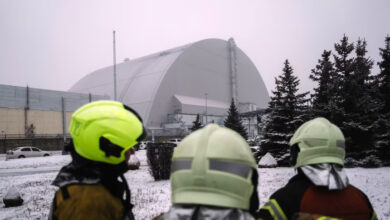
(CNN) – The US successfully tested a hypersonic missile in mid-March but kept it quiet for two weeks to avoid escalating tensions with Russia as President Joe Biden was about to travel to Europe, according to a defense official familiar with the matter.
The Hypersonic Air-breathing Weapon Concept (HAWC) was launched from a B-52 bomber off the west coast, the official said, in the first successful test of the Lockheed Martin version of the system. A booster engine accelerated the missile to high speed, at which point the air-breathing scramjet engine ignited and propelled the missile at hypersonic speeds of Mach 5 and above.
The official offered scant details of the missile test, only noting the missile flew above 65,000 feet and for more than 300 miles. But even at the lower end of hypersonic range — about 3,800 miles per hour — a flight of 300 miles is less than 5 minutes.
The test came days after Russia says it used its own hypersonic missile during its invasion of Ukraine, claiming it targeted an ammunition warehouse in western Ukraine.
US officials downplayed the significance of the Russian use of their hypersonic Kinzhal missile. Defense Secretary Lloyd Austin said he did not view it as “some sort of game changer” after the Russians announced the missile launch. Days later, Pentagon press secretary John Kirby said it was “hard to know what exactly the justification” was for the launch, since it targeted a stationary storage facility.
“That’s a pretty significant sledgehammer to take out a target like that,” Kirby said at the time.
The Kinzhal missile is simply an air-launched version of the Russian Iskander short-range ballistic missile. In other words, it is a variation of an established technology as opposed to a revolution in hypersonic weaponry. The US test was of a more sophisticated and difficult air-breathing scramjet engine. The HAWC missile also has no warhead, instead relying on its kinetic energy to destroy the target.
At the time of the US test, Biden was preparing for a visit to NATO allies in Europe, including a stop in Poland where he met with Ukraine’s foreign minister and defense minister.
The US has been careful not to take steps or make statements that could unnecessarily escalate the tensions between Washington and Moscow. On Friday, the US canceled a test of the Minuteman III intercontinental ballistic missile (ICBM) to avoid any misinterpretation by Russia. Austin had already postponed the test in early March to avoid any actions that could be misconstrued by Russia at such a sensitive time.
In general, the US has also remained somewhat discreet about the weapons and equipment it sends into Ukraine. Only in the latest $300 million security assistance package did the Defense Department list specific systems and weapons.
The US has also opposed the transfer of fighter aircraft to Ukraine through the United States, concerned that the Kremlin could interpret such a move as the US and NATO entering the conflict in Ukraine.
US officials remained quiet about this latest hypersonic test for two weeks for similar reasons, the defense official said, careful not to provoke the Kremlin or President Vladimir Putin, especially as Russian forces expanded their bombardment of Ukraine.
The US test is the second successful test of a HAWC missile, and it is the first of the Lockheed Martin version of the weapon. Last September, the Air Force tested the Raytheon HAWC, powered by a Northrop Grumman scramjet engine.
The test met all primary objectives, according to a press release from the Defense Advanced Research Projects Agency (DARPA), including the missile’s integration and release, safe separation from the launch aircraft, booster firing, and cruise. Then too officials offered few details about the flight, with no mention of how fast the missile flew or what distance it traveled. The release only stated that the missile traveled at speeds greater than Mach 5.
The US has placed a renewed emphasis on hypersonic weapons following successful Russian and Chinese tests in recent months, exacerbating the concern in Washington that the US is falling behind on a military technology considered critical for the future.
In the FY23 defense budget, the Biden administration has requested $7.2 billion for long range fires, including hypersonic missiles. In a report last year, the Government Accountability Office identified 70 efforts related to the development of hypersonic weapons, expected to cost nearly $15 billion between 2015 and 2024.
One month after the first successful HAWC test, the US suffered a setback when the test of a different hypersonic system failed. The failure came just as reports emerged that China had successfully tested a hypersonic glide vehicle over the summer and shortly after Russia claimed to have successfully tested its submarine-launched hypersonic missile, dubbed the Tsirkon.




